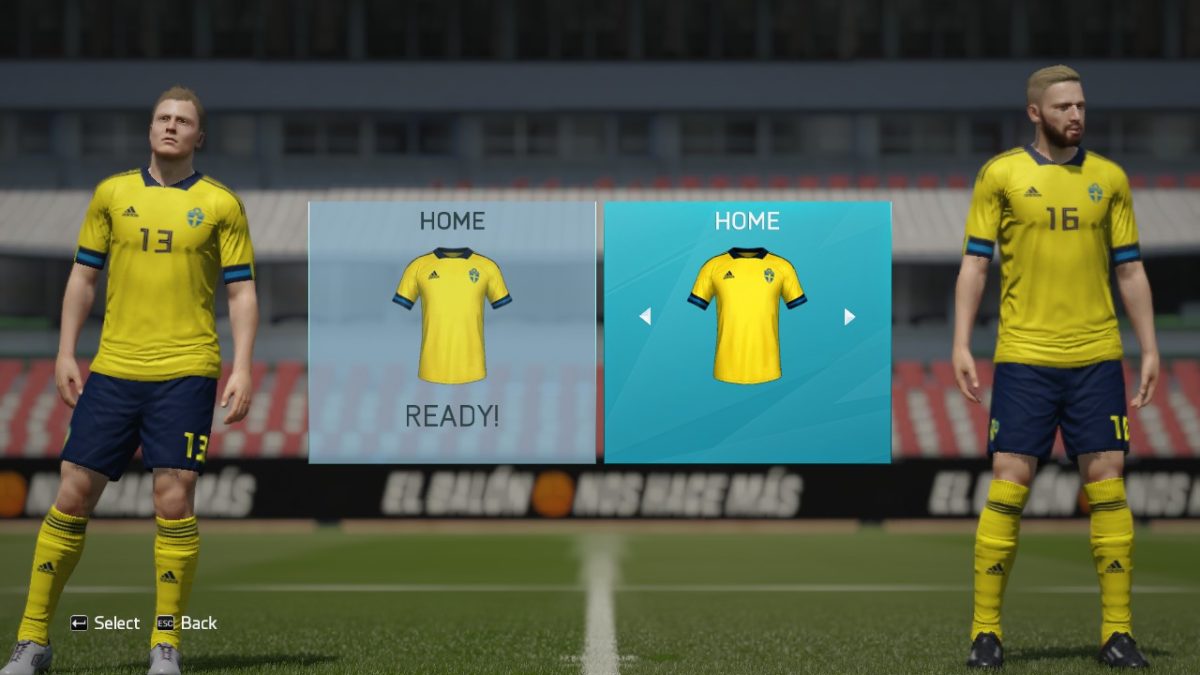- Sweden Euro 2020 Kitsempty Spaces The Blog 2017
- Sweden Euro 2020 Kitsempty Spaces The Blog Youtube
- Sweden Euro 2020 Kitsempty Spaces The Blog 2016

Red: 44, 1, 7 white: 56 blue: 12, 20, 39 navy (away): 7, 13, 18 old red: 42, 0, 5 light blue: 0, 36, 55 blue:0, 23, 50 dark teal (gk away): 6, 14, 16 grey: 25, 27, 25. The Home, Away and Goalkeeper 'Adidas' kits of Sweden National Team that play in UEFA in Europe for the season 19/20 and especially for Euro 2020. These kits can be used for FIFA 16, FIFA 15 and FIFA 14, in PNG and RX3 format files + MiniKits and Logos. European neighbours restrict travel to Britain as new coronavirus strain spreads. Italy, December 20, 2020. Sweden said it was preparing a decision to ban entry from the United Kingdom. The share of multifamily investment in 2020 (up to Q3) increased by 33 per cent yoy. The living sectors are expected to capture at least one fifth of market activity this year, making them the second largest sector after offices and the new core. Further information. Contact Eri Mitsostergiou. Read more: European Property Themes 2021. November 22, 2020 Topic: History Region: Europe. Blog Brand: The Reboot Tags: Russia Military NATO Saab 36 Technology Nuclear Weapons Saab 36: Sweden's Plan for a Nuclear Supersonic Bomber to.

Sweden Euro 2020 Kitsempty Spaces The Blog 2017
Studying in Sweden does not have to be expensive: If you look in the right places you will find that studying abroad could be very easy, and in some cases even free of charge! Unfortunately, not every student can study for free in Sweden, but in this article you will find out if it is possible for you to study for free, or what the tuition fees may be.
Who can study in Sweden for free?
If you have a passport from a country of the EU/EEA or Switzerland, you are eligible to study in Sweden for free! If you are a passport holder from any other country, unfortunately the cost is a bit higher: The Swedish government introduced tuition fees for students from outside the EU/EEA and Switzerland, starting in the autumn semester 2011. That made Sweden one of the more expensive European destinations for international students. Today, tuition costs range from 80,000 SEK (around 8,000 euros) a year to 190,000 SEK (around 19,000 euros) a year based on the program in which you are studying, and the university that you wish to attend. Bachelor programs are generally a much lower cost than the average master’s program. Although this may be an expensive choice to some, students that choose to come to Sweden to study will obtain a high class education which will open up doors worldwide for exciting career opportunities upon graduation.

How can I receive a scholarship to study in Sweden?
There are many different ways that students can obtain a scholarship to study in Sweden. The opportunity to study in Sweden may be right in front of you with multiple scholarship opportunities. The Swedish Institute (SI) lists a large variety of scholarships that are available based on the subject you wish to study as well as your nationality.
Can I study in Sweden for free if I am from Asia, Africa or elsewhere outside Europe?
Yes, you can! Although you will likely have to pay tuition fees for full degree programs, there is a way to avoid the tuition fees: If you are enrolled in a school that is a partner university to universities in Sweden, you can take part in their study abroad exchange programs. For example, Lund University has more than 600 partner universities in 70 countries worldwide. If you are studying at a university already, and wish to study in Sweden, check with the internationals office at your university!
How expensive is it to live in Sweden?

The cost of living in Sweden varies based on where you are living. If you are studying at one of the schools in the country’s capital, Stockholm, you should be prepared to pay much more than if you are studying in a smaller city like Borås. Around the country, the monthly expenses are on average about 8,000 SEK (800 euros). The hardest part of studying in one of the big cities is finding housing. In some of the bigger cities, there are not enough student housing options; however, there are websites available in which people are willing to open their homes and apartments to share with other students within the same city. Finding these opportunities is very important if you wish to save money while studying at a university in Sweden. When applying for a Bachelors or Masters programme in Sweden, you will need to prove to the migration authorities that you will be able to successfully finance yourself during the time that you will be living in the country.
How easy is it to communicate with the locals?
Children in Sweden begin learning English at a very young age, in some cities as young as 7 years old. And all foreign movies and shows are shown in their original language with Swedish subtitles, meaning that Swedes get exposure to English every day. Due to this, almost everyone that you encounter will be able to speak English. However, if you wish to fully engage in the society, it is recommended that you take Swedish courses while studying if possible. You can study in these courses for free if you have obtained residency for the duration of your studies.
If you wish to study in Sweden, you should do your research first, start saving, and begin the hunt for an apartment as soon as you have the approval to relocate!
About the author:
Kenzee Haapasaari has a bachelors degree in English and a masters degree in Education. While studying she found a passion for writing, education, and travelling. Upon graduating from university in 2015 she relocated from a small town in Kentucky to Stockholm, Sweden, where she is currently based.
- Luxembourg has the highest percentage of designated nature space in Europe – 76% of land is protected!
- Slovenia (72%) and Malta (65%) have the second and third largest protected terrestrial areas
- Bosnia and Herzegovina place as the country with the smallest percentage of protected natural sites (4%)
- Germany, Sweden and Switzerland have the largest number of designated areas; although, they don’t cover as much space in km2
2020 was the year of staycations and learning to love the nature that’s around you – The New York Times recently reported a surge of European nature lovers visiting protected areas for the first time. But which country does the best job at protecting their natural sites?
SaveOnEnergy.com/uk analysed almost 80,000 nationally protected terrestrial areas in Europe, calculating the percentage of protected space per country, to discover who makes the biggest attempt to preserve their natural terrene.
RESULTS
Which country has the highest percentage of protected terrestrial areas?
Thanks to protected sites such as Geopark Mëllerdall and Naturpark Our, SaveOnEnergy.com/uk can reveal that Luxembourg is the European country with the highest percentage of protected land (76%). Luxembourg is one of the smallest countries in Europe (2,586 km2) and is home to just 134 designated areas, but with these areas covering 1,963 km2 they take first place.
In second place is Slovenia, with 72% of their country’s nature being protected, the country has a whopping 1,891 designated areas.
Sweden Euro 2020 Kitsempty Spaces The Blog Youtube
Malta has the third-highest percentage of protected terrestrial land in Europe! Covering 65% of their land, there are 250 sites for locals to enjoy such as Għar Dalam cave, Maqluba and Mdina.
Cyprus (57 designated areas) and Liechtenstein (44 designated areas) place fourth and fifth, as 56% and 45% of their country’s land is protected by legislation.
Top complete the top 10 countries with the highest percentage of protected terrestrial land:
6. Netherlands: 44%
7. UnitedKingdom: 36%
8. Austria: 33%
9. Poland: 33%
10. Germany: 31%

Which country has the lowest percentage of protected terrestrial areas?
At just 4%, SaveOnEnergy found that Bosnia and Herzegovina is the country with the smallest percentage of protected nature in Europe. Although there are 40 designated sites, they only cover 1,922 km2 of the country’s 192,232 km2 land.
Protecting just 6% of their terrestrial land, Romania places second to last. Despite having many designated areas, such as Dealul Zackel and Cindrel, they aren’t widely spread across the country.
Completing the bottom five are Serbia, Belgium and Portugal, with just 7%, 8% and 9% of their land protected respectively.
Which country has the largest number of protected terrestrial areas?
Germany is home to the most designated terrestrial land! With a whopping 17,654 areas, they top the ranks.
Sweden places in second as 15,254 areas have been protected by legislation in the country.
Following in third, fourth and fifth position are Switzerland with 10,423, the United Kingdom with 9,032 and France with 3,812.
On the other end, SaveOnEnergy.com/uk found that Bosnia and Herzegovina is the country with the smallest number of protected sites – 40. They are followed by Liechtenstein (44), Montenegro (54) and Cyprus (57).
Sweden Euro 2020 Kitsempty Spaces The Blog 2016
Please see the full blog post for more information: https://www.saveonenergy.com/uk/protected-land-in-european-countries/
Methodology & Notes:
- SaveOnEnergy.com/uk analysed the European Environment Agency’s list of nationally designated areas to discover the total number of designated and respective protected areas in each European country, as of 2020.
- They then found the total area of each country to calculate the percentage of protected space per country.
- SaveOnEnergy only considered the protected terrestrial areas of each country for this research – ‘marine’, ‘marine and terrestrial’ and ‘heritage’ sites were not included. The sites that spill over into other countries were also removed.
A ‘nationally designated protected area’ is an area protected by national legislation.
Terrestrial protected areas are totally or partially protected areas that are designated by national authorities as scientific reserves with limited public access, national parks, natural monuments, nature reserves or wildlife sanctuaries, protected landscapes, and areas managed mainly for sustainable use.
Estonia, Finland, Ireland and Turkey were removed from the data as EEA does not have permission to distribute some or all sites by the countries.
Comments
0 comments




